
(a)
Interpretation:
The product which is formed by the reaction of
Concept introduction:
The curved-arrow notation is used to show the transfer of electrons from one atom to another. The curved arrow has two barbs (head and tail) which represent the direction of electron flow.
Answer to Problem 20.31AP
The curved arrow notation and product for the reaction of

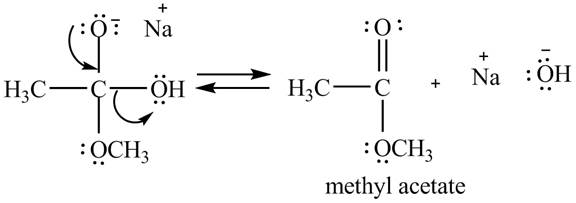
Explanation of Solution
The treatment of sodium methoxide with a
In the first step, the electron pairs of oxygen present in methoxide ion attacks the acyl carbon atom of acetic acid and bonding pair of electrons present in the pi bond of acyl group shifts towards oxygen atom simultaneously. Due this an intermediate is formed as shown below.

Figure 1
In the second step, the regeneration of the acyl group takes place by the movement of electron pair of negative charged oxygen atom and also the removal of hydroxide ion takes place from the intermediate simultaneously. Hydroxide ion gets removed by grabbing the electron pair of

Figure 2
Therefore, methyl acetate is desired product formed by the reaction of
The curved arrow notation and product for the reaction of
(b)
Interpretation:
The product which is formed by the reaction of
Concept introduction:
The curved-arrow notation is used to show the transfer of electrons from one atom to another. The curved arrow has two barbs (head and tail) which represent the direction of electron flow.
Answer to Problem 20.31AP
The curved arrow notation and product for the reaction of ![]() of acetic acid are shown below.
of acetic acid are shown below.

Explanation of Solution
The treatment of a base like

Figure 3
Therefore, cesium acetate is desired product formed by the reaction of ![]() of
of
The curved arrow notation and product for the reaction of
(c)
Interpretation:
The product which is formed by the reaction of ![]() of acetic acid and the corresponding curved-arrow notation are to be stated.
of acetic acid and the corresponding curved-arrow notation are to be stated.
Concept introduction:
The curved-arrow notation is used to show the transfer of electrons from one atom to another. The curved arrow has two barbs (head and tail) which represent the direction of electron flow.
Answer to Problem 20.31AP
The curved arrow notation and product for the reaction of


Explanation of Solution
The treatment of Grignard reagent with a carboxylic acid results into a nucleophilic substitution reaction. The steps for the formation of the product of the reaction between
In the first step, the bonding electron pairs of

Figure 4
In the second step, the regeneration of the acyl group takes place by the movement of electron pair of negative charged oxygen atom and also the removal of hydroxide ion takes place from the intermediate simultaneously. Hydroxide ion gets removed by grabbing the electron pair of

Figure 5
Therefore, ![]() of
of
The curved arrow notation and product for the reaction of
(d)
Interpretation:
The product which is formed by the reaction of
Concept introduction:
The curved-arrow notation is used to show the transfer of electrons from one atom to another. The curved arrow has two barbs (head and tail) which represent the direction of electron flow.
Answer to Problem 20.31AP
The curved arrow notation and product for the reaction of

Explanation of Solution
The treatment of a base like

Figure 6
Therefore, lithium acetate is desired product formed by the reaction of
The curved arrow notation and product for the reaction of
(e)
Interpretation:
The product which is formed by the reaction of
Concept introduction:
The curved-arrow notation is used to show the transfer of electrons from one atom to another. The curved arrow has two barbs (head and tail) which represent the direction of electron flow.
Answer to Problem 20.31AP
The curved arrow notation and product for the reaction of

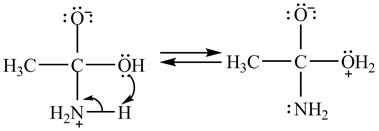
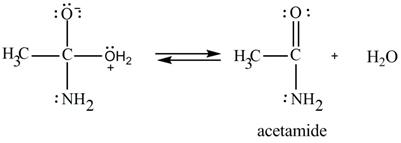
Explanation of Solution
The treatment of ammonia with a carboxylic acid results into a nucleophilic acyl substitution reaction. The steps for the formation of the product of the reaction between
In the first step, the lone of pair of electrons of

Figure 7
In the second step, electron pairs of oxygen in
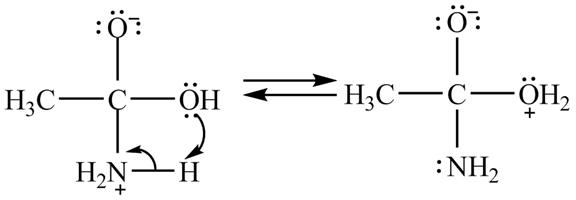
Figure 8
In the third step, the regeneration of the acyl group takes place by the movement of electron pair of negative charged oxygen atom and also the removal of hydroxide ion takes place from the intermediate simultaneously. Hydroxide ion gets removed by grabbing the electron pair of
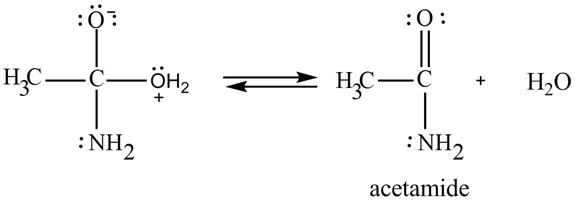
Figure 9
Therefore,
The curved arrow notation and product for the reaction of
(f)
Interpretation:
The product which is formed by the reaction of
Concept introduction:
The curved-arrow notation is used to show the transfer of electrons from one atom to another. The curved arrow has two barbs (head and tail) which represent the direction of electron flow.
Answer to Problem 20.31AP
The curved arrow notation and product for the reaction of

Explanation of Solution
The treatment of a base like

Figure 10
Therefore, sodium acetate is desired product formed by the reaction of
The curved arrow notation and product for the reaction of
(g)
Interpretation:
The product which is formed by the reaction of
Concept introduction:
The curved-arrow notation is used to show the transfer of electrons from one atom to another. The curved arrow has two barbs (head and tail) which represent the direction of electron flow.
Answer to Problem 20.31AP
The curved arrow notation and product for the reaction of

Explanation of Solution
The given compound is shown below.
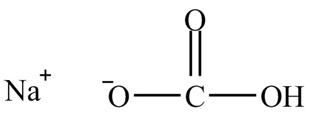
Figure 11
The given compound is sodium hydrogencarbonate. The treatment of a base like sodium hydrogencarbonate with acetic acid produces a salt known as sodium acetate. In the first step of the reaction between

Figure 12
Therefore, sodium acetate is desired product formed by the reaction of
The curved arrow notation and product for the reaction of
Want to see more full solutions like this?
Chapter 20 Solutions
Organic Chemistry, Ebook And Single-course Homework Access
- Draw the Michael Adduct and the final product of the Robinson annulation reaction. Ignore inorganic byproducts.arrow_forwardDraw the Michael adduct and final product of the Robinson annulation reaction. Ignore inorganic byproductsarrow_forwardPost Lab Questions. 1) Draw the mechanism of your Diels-Alder cycloaddition. 2) Only one isomer of product is formed in the Diels-Alder cycloaddition. Why? 3) Imagine that you used isoprene as diene - in that case you don't have to worry about assigning endo vs exo. Draw the "endo" and "exo" products of the Diels-Alder reaction between isoprene and maleic anhydride, and explain why the distinction is irrelevant here. 4) This does not hold for other dienes. Draw the exo and endo products of the reaction of cyclohexadiene with maleic anhydride. Make sure you label your answers properly as endo or exo. 100 °C Xylenes ??? 5) Calculate the process mass intensity for your specific reaction (make sure to use your actual amounts of reagent).arrow_forward
- Indicate the product(s) A, B C and D that are formed in the reaction: H + NH-NH-CH [A+B] [C+D] hydrazonesarrow_forwardHow can you prepare a 6 mL solution of 6% H2O2, if we have a bottle of 30% H2O2?arrow_forwardHow many mL of H2O2 from the 30% bottle must be collected to prepare 6 mL of 6% H2O2.arrow_forward
- Indicate the product(s) B and C that are formed in the reaction: HN' OCH HC1 B + mayoritario C minoritario OCH3arrow_forwardIndicate the product(s) that are formed in the reaction: NH-NH, OCH3 -H₂O OCH3arrow_forward21.38 Arrange the molecules in each set in order of increasing acidity (from least acidic to most acidic). OH OH SH NH2 8 NH3 OH (b) OH OH OH (c) & & & CH3 NO2 21.39 Explain the trends in the acidity of phenol and the monofluoro derivatives of phenol. OH OH OH OH PK 10.0 PK 8.81 PK 9.28 PK 9.81arrow_forward
- identify which spectrum is for acetaminophen and which is for phenacetinarrow_forwardThe Concept of Aromaticity 21.15 State the number of 2p orbital electrons in each molecule or ion. (a) (b) (e) (f) (c) (d) (h) (i) DA (k) 21.16 Which of the molecules and ions given in Problem 21.15 are aromatic according to the Hückel criteria? Which, if planar, would be antiaromatic? 21.17 Which of the following structures are considered aromatic according to the Hückel criteria? ---0-0 (a) (b) (c) (d) (e) (h) H -H .8.0- 21.18 Which of the molecules and ions from Problem 21.17 have electrons donated by a heteroatom?arrow_forward1. Show the steps necessary to make 2-methyl-4-nonene using a Wittig reaction. Start with triphenylphosphine and an alkyl halide. After that you may use any other organic or inorganic reagents. 2. Write in the product of this reaction: CH3 CH₂ (C6H5)₂CuLi H₂O+arrow_forward
 Organic ChemistryChemistryISBN:9781305580350Author:William H. Brown, Brent L. Iverson, Eric Anslyn, Christopher S. FootePublisher:Cengage Learning
Organic ChemistryChemistryISBN:9781305580350Author:William H. Brown, Brent L. Iverson, Eric Anslyn, Christopher S. FootePublisher:Cengage Learning
